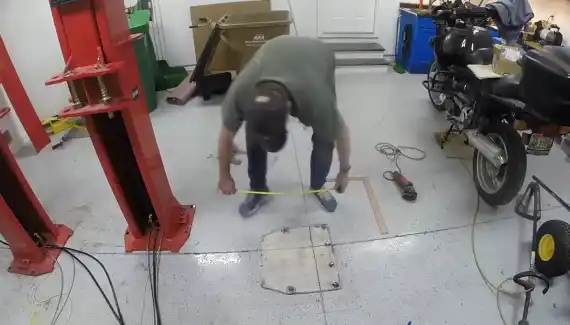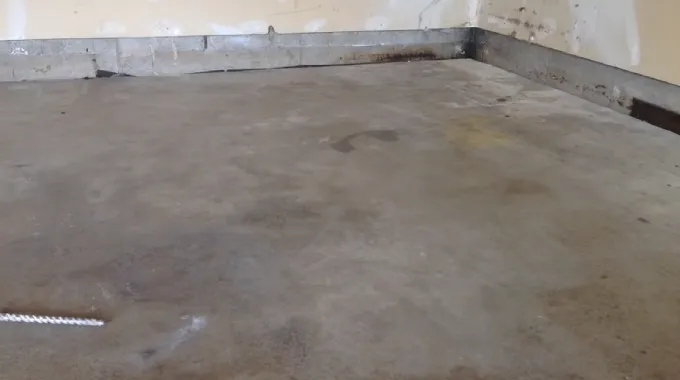Last Updated on June 21, 2023
Are you looking to install a car lift in your garage? If so, you’ll want to ensure that the garage floor is thick enough to support the lift. Installing a car lift in your garage requires special consideration, especially regarding the floor’s thickness.
The truth is that there isn’t one universal answer here since different flooring materials require different depths. While some garage floors may require as little as 4 inches, most experts recommend having at least 6 to 8 inches of thick flooring for the safest possible car lift installation.
Let’s explore which garage flooring is most appropriate for a car lift and how much PSI flooring strength is needed. Ready to find out how thick your garage floor should be? Read on to find more.
How Thick Should a Garage Floor be For a Lift to Perfectly Accommodate?

To fit a car lift properly, the garage floor must be at least six to eight inches thick. This thickness is necessary to ensure the safest environment for people and equipment.
The extra thickness also helps ensure that there is room for proper drainage so that the lift and the surrounding area are not negatively affected by moisture or debris. Having a thicker garage floor can help reduce vibration and noise levels in the space, making it more comfortable and pleasant to use.
Thicker floors provide more durability and can protect against wear and tear caused by vehicles and heavy loads. Furthermore, thicker floors are better suited to handle weight distribution, as they allow for more even weight distribution from different parts of the lift.
How Do You Determine the Thickness of Your Garage Floor for a Car Lift?
When looking for garage flooring, it’s important to keep in mind that the thickness of a garage floor depends on a variety of factors, such as:
Weight Capacity Requirements
Considering the weight capacity of your lift is crucial when determining how thick your garage floor should be. Generally, heavier lifts and vehicles require more robust foundations to support them properly.
For example, if you have a car or SUV with a heavier weight capacity, you may need at least six inches or more of flooring for maximum safety and stability. On the other hand, lighter vehicles may only require four inches or less, depending on their design and size.
Garage Flooring Material
The flooring material used for construction can also affect your garage floor’s thickness. Concrete floors are generally much thicker than other materials like asphalt or wood, so they can provide more stability when supporting heavy equipment like lifts.
However, asphalt floors tend to flex slightly under pressure, so they may need additional reinforcement if supporting a heavy load. Wood floors can provide adequate support, but they may also need extra reinforcement depending on their thickness level.
Construction Quality
Finally, consider how thick your garage floor needs to be in its overall construction quality. A poorly-constructed floor will not offer enough stability and strength to support any equipment.
It is important to ensure that any newly-installed floor is constructed with high-quality materials before installing any type of machinery.
Which Garage Floor Material is Most Compatible With a Car Lift?

The most compatible material for a car lift is a solid and sturdy concrete garage floor. Concrete is incredibly durable, can withstand heavy loads, and provide an even surface for a car lift to operate properly. Its strength makes it a great candidate for use in garages where vehicle maintenance and repairs occur.
Since it can withstand high-pressure levels, it supports a car lift or jacking system, such as a car or UTV floor jack. Using the best utv floor jack puts less stress on the floor because it is lightweight yet durable with high load capacity & lifting height.
Concrete also offers superior traction, which helps keep your vehicle in place while being worked on. Plus, oil spills won’t happen since there are no gaps between concrete slabs.
In addition to its strength and durability, concrete offers several other advantages when used with a car lift in the garage environment. For instance, with concrete, you won’t need to worry about debris, such as small rocks or dirt getting underneath your vehicle, as sometimes happens with other flooring options.
Also, if you install radiant heating beneath your concrete slab, you’ll enjoy additional comfort when working on your vehicle inside the garage during cold winter days.
How to Pour Concrete on a Garage Floor for a Car Lift?
Pouring a floor for a car lift requires special attention to detail and proper subfloor preparation. Whether you’re pouring the concrete yourself or hiring professionals, following the steps outlined here will help you create a smooth, even surface that is safe to work on.
Step 1: Preparing the Selected Subfloor
Before pouring concrete, check any existing subfloor for any damage or irregularities. If there are cracks or uneven surfaces, fill them with a patching compound so that the new concrete will be even and level. Make sure debris such as dust, dirt, and gravel is removed from the area.
Step 2: Choose Your Concrete Mix

The type of concrete mix you use will depend on your specific needs. Use a mix designed specifically for garage floors if possible. It should be able to withstand heavy loads and have good strength properties. Depending on how much weight your car lift will put on the floor, you may also need to add an additive.
Step 3: Mark Out the Area
Use chalk lines or string around the edges of where you want to pour the concrete, so you know where to stop pouring when it’s time. This is especially important if you add materials like carpeting or tile afterward.
Step 4: Pour & Spread Evenly
Start by pouring small amounts at a time and spreading it evenly with a shovel or trowel until all areas are covered. Be sure to maintain consistent depth throughout (usually about 6 inches is ideal) and ensure no gaps between poured concrete sections while they’re still wet.
Step 5: Level & Float
After all, areas have been spread out evenly, level high spots with a long straightedge tool or 2×4 lumber piece, then use a hand trowel (also known as floating) to remove excess water from the surface and create a smoother finish.
This should be done quickly after spreading out each section so that it doesn’t dry too quickly before finishing can be done correctly.
Step 6: Allow Concrete to Cure
Once everything has been leveled off and floated properly, allow your freshly poured garage concrete floor to cure for at least 48-72 hours before driving anything over it (or longer in colder climates), this allows enough time for it to harden completely.
Cover your newly poured floor with plastic sheeting overnight (if needed) to protect it from temperature changes. This can prevent cracking due to moisture evaporating too quickly, which could cause delamination of your new concrete floor over time if not taken care of properly.
Should the Garage Floor Need to Meet Any Regulations or Safety Standards for a Car Lift?
Before installing a vehicle lift in your home garage, you must follow relevant safety standards and regulations, such as those set by OSHA (Occupational Safety and Health Administration) or ANSI (American National Standards Institute).
For example, OSHA requires that the maximum rated capacity of a vehicle lift must be marked on the device itself. Additionally, the workshop should have adequate ventilation so that toxic fumes do not build up during operation.
The flooring beneath the car two post lift must also meet certain criteria to be safe. Generally, this means installing concrete pads at least 4 inches thick beneath each corner of the lift and ensuring that they are level with one another.
Any unevenness or movement in these pads could cause instability while using the lift, resulting in injury or property damage. Also, if any part of your garage floor is cracked or damaged, this should be fixed before installation.
To ensure proper installation of your car lift’s concrete pads, it’s best practice to enlist professional help from a qualified technician. They will know exactly how thick and level they need to be installed to function safely and efficiently.
How Much is PSI Strength of Concrete Needed for a Garage Car Lift?

When picking the right PSI strength of concrete for a garage lift, most people will tell you that 3,500 PSI is considered the minimum amount needed. Due to PSI’s higher strength, the concrete slab can handle heavy traffic and is resistant to surface wear.
For some projects, however, more than 3,500 PSI may be needed. If a structure like a post-tensioned garage lift is being constructed on top of a concrete slab, then an even higher-strength mix should be used.
Concrete with 4,000–5,000 PSI can provide superior compressive strength and greater tensile strength than standard mixes. This product is designed specifically to resist any flexing or movement within the slab itself, which can cause cracking and long-term damage.
Even though 3,500 PSI is a lot of strength for many applications, such as post-tensioned garage lifts, you need a mix that’s thick enough and strong enough to meet building codes and last a long time.
Ensure a Secure Auto Lift: Measure Your Garage Floor Thickness Carefully
Knowing your garage floor’s thickness is essential before installing a car lift. The ideal thickness for a garage concrete floor depends on various factors, such as the type of material used, regulations and safety standards, and the PSI strength of concrete.
Harder materials like concrete are better suited for car lifts because they support more weight than softer materials like wood or linoleum. Concrete should be poured at least six inches thick and have a minimum PSI strength of 3500 to support the weight of a vehicle.
Overall, correctly determining the garage floor depth for your car lift is essential for safety and longevity reasons. If done correctly, a new car lift installation can turn your ordinary garage into a unique space that meets all your automotive needs.

